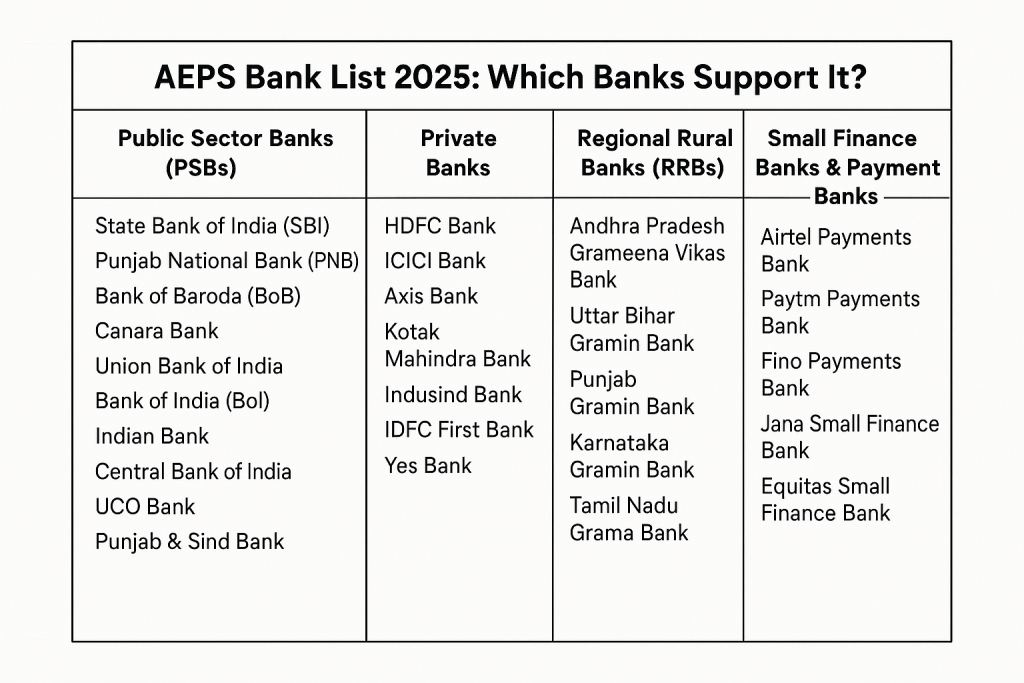If you’re looking for a convenient way to perform basic banking transactions without a debit card or visiting a branch, AEPS (Aadhaar Enabled Payment System) is the solution. But which banks support AEPS in 2025? This in-depth guide covers everything you need to know—from the updated AEPS bank list to how it works, benefits, and FAQs.
What is AEPS?
AEPS (Aadhaar Enabled Payment System) is a bank-led digital payment model that allows users to carry out financial transactions using only their Aadhaar number and biometric authentication (fingerprint/iris scan). Introduced by the National Payments Corporation of India (NPCI), AEPS eliminates the need for physical cards, PINs, or mobile apps.
Key Transactions Supported by AEPS:
-
Cash Withdrawal
-
Balance Enquiry
-
Mini Statement
-
Aadhaar to Aadhaar Fund Transfer
-
BHIM Aadhaar Pay (Merchant Payments)

AEPS Bank List 2025: Which Banks Support It?
Almost all major public sector, private, and regional rural banks (RRBs) in India support AEPS. Below is the updated AEPS bank list for 2025, categorized for easy reference.
1. Public Sector Banks (PSBs) Supporting AEPS
These government-owned banks are fully integrated with AEPS:
-
State Bank of India (SBI)
-
Punjab National Bank (PNB)
-
Bank of Baroda (BoB)
-
Canara Bank
-
Union Bank of India
-
Bank of India (BoI)
-
Indian Bank
-
Central Bank of India
-
UCO Bank
-
Punjab & Sind Bank
2. Private Banks Supporting AEPS
Many private banks also participate in AEPS transactions:
-
HDFC Bank
-
ICICI Bank
-
Axis Bank
-
Kotak Mahindra Bank
-
IndusInd Bank
-
IDFC First Bank
-
Yes Bank
3. Regional Rural Banks (RRBs) Supporting AEPS
Several RRBs allow AEPS-based banking:
-
Andhra Pradesh Grameena Vikas Bank
-
Uttar Bihar Gramin Bank
-
Punjab Gramin Bank
-
Karnataka Gramin Bank
-
Tamil Nadu Grama Bank
4. Small Finance Banks & Payment Banks
Even newer banking models support AEPS:
-
Airtel Payments Bank
-
Paytm Payments Bank
-
Fino Payments Bank
-
Jana Small Finance Bank
-
Equitas Small Finance Bank
(Note: The list is subject to updates. Always verify with your bank or the NPCI website.)
How to Use AEPS for Transactions?
To use AEPS, follow these steps:
-
Visit an AEPS-enabled Micro ATM or Business Correspondent (BC) outlet.
-
Select the type of transaction (e.g., cash withdrawal).
-
Enter your Aadhaar number.
-
Choose your bank name.
-
Authenticate via fingerprint/iris scan.
-
Complete the transaction.
Benefits of AEPS
-
No need for debit cards or PINs – Just Aadhaar and biometrics.
-
Accessible in rural areas – Works even without internet.
-
Secure transactions – Biometric authentication reduces fraud.
-
Wide acceptance – Supported by most Indian banks.
Limitations of AEPS
-
Biometric failures can sometimes delay transactions.
-
Daily transaction limits apply (usually ₹10,000 per day).
-
Dependence on banking correspondents in remote areas.

Frequently Asked Questions (FAQs)
1. Is AEPS free to use?
Most banks do not charge for AEPS transactions, but some BC agents may apply a nominal fee (₹5-₹20 per withdrawal).
2. Can I use AEPS without a bank account?
No, your Aadhaar must be linked to a bank account for AEPS transactions.
3. What if my fingerprint doesn’t work?
You can use Iris scan authentication or visit your bank branch to update biometrics in Aadhaar.
4. Is AEPS safe?
Yes, since it requires biometric verification, it’s more secure than OTP or card-based transactions.
5. How do I check if my bank supports AEPS?
Visit the NPCI website or contact your bank’s customer care.
Conclusion
AEPS is a game-changer for financial inclusion in India, especially for rural populations and those without smartphones. With almost all major banks supporting it in 2025, AEPS makes banking simpler and more accessible.
Before using AEPS, ensure your Aadhaar is linked to your bank account and your biometrics are updated. If your bank isn’t listed, check with NPCI for the latest updates.
Disclaimer
This article is for educational purposes only. For official confirmation on AEPS-supported banks, refer to the NPCI or your bank’s website. If you have any concerns regarding this content, please visit our DMCA page for removal requests. Verify all details before making financial decisions.
